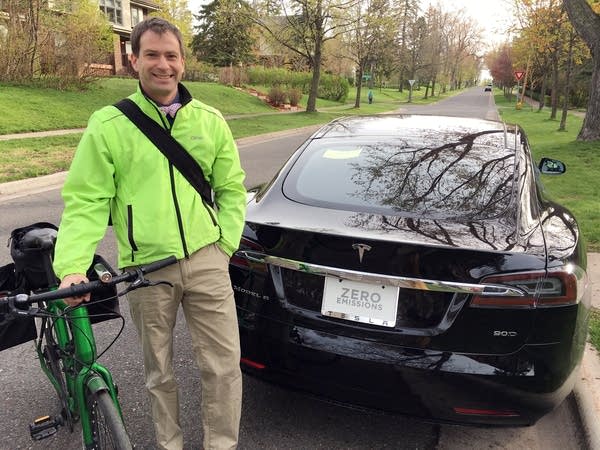MN's greenhouse gas goal flopped. New goal: 'electrify everything'

With great fanfare, Republican Gov. Tim Pawlenty signed an audacious, bipartisan law on May 25, 2007 called the Next Generation Energy Act, which pledged to cut the state's greenhouse gas emissions a whopping 80 percent by 2050.
"The nation has been asleep at the switch," Pawlenty said at the time. "But here in Minnesota we are kick-starting the future by increasing our nation-leading per capita renewable fuel use, boosting cost saving measures and tackling greenhouse gas emissions."
Fast forward 10 years and the state has significantly boosted renewable energy use. But despite that success, Minnesota's fallen woefully short of its goals to tackle greenhouse gases, cutting emissions so far by only about 4 percent from 2005 levels.
Lawmakers in 2007 set an 80 percent emissions cut to get Minnesota to the levels most experts agree are needed to stave off the most catastrophic impacts of climate change.
Create a More Connected Minnesota
MPR News is your trusted resource for the news you need. With your support, MPR News brings accessible, courageous journalism and authentic conversation to everyone - free of paywalls and barriers. Your gift makes a difference.
But the state has missed its 2015 goal under the law, and "frankly we're not going to make the 2025 goal. But we are starting to think more realistically about what do we have to do between now and 2050 to try to achieve the 2050 goal," said David Thornton, assistant commissioner of the Minnesota Pollution Control Agency.
A big part of that strategy, many experts agree, is to take the gains the state has made in greening its electricity grid — renewable energy now accounts for more than 20 percent of the state's electricity generation, and is forecast to grow to 37 percent by 2030 — and transfer that to other sectors of the economy.
"We think the key to meeting our climate goals going forward, reaching into those other sectors, would be to electrify everything," said Mike Bull, policy director for the Center on Energy and the Environment. "To use electricity in transportation, in space heating, water heating, areas that are now primarily powered by fossil fuels. That's the future."
But Bull, who 10 years ago was Pawlenty's point person on the Next Generation Energy Act, admits getting to that future is not easy. There are only a few dozen power plants in the state. But there are millions of farms, buildings, and cars and trucks.
As emissions from electric utilities continue to drop, the transportation sector is expected to soon become the leading emitter of greenhouse gasses in the state. It already is nationally.
But the effort to electrify Minnesota's cars and trucks is lagging many other states. Last year, out of nearly a quarter million new vehicles registered in the state, only about 2 percent were electric cars. There are fewer than 4,000 plug-in electric vehicles on Minnesota's roads — a figure that doesn't count gas-electric hybrids.
But, those numbers are growing quickly. Sales of plug-in electric vehicles more than doubled between 2015 and 2016.
Duluth physician Dr. Andrew Nisbet recently forked over more than $100,000 to buy a new Tesla electric sedan. "To me the issue of climate change and our efforts to reduce our carbon footprint," he said, "are next in line in my level of concern to my kids and wife."
Nisbet is the first customer to sign up for a Minnesota Power pilot program to get a discounted rate for charging the car overnight, when there's excess wind energy on the grid.
Depending on when and where you charge it, an electric vehicle in Minnesota emits between 50 and 95 percent fewer greenhouse gas emissions than a gas-powered car, said Brendan Jordan, who leads a partnership called Drive Electric Minnesota for the Great Plains Institute.
This year could be a tipping point for electric vehicles, he added, with several more affordable models hitting the market that can travel more than 200 miles on a single charge.
"We have an opportunity where sales could really increase," he said. "But we have to be ready as a state."
The Minnesota Department of Transportation is working with four other states to rebrand Interstate 94 between Michigan and Minnesota as the Great Lakes Zero Emission Corridor.
The goal is to install charging stations every 75 miles or fewer along the entire route where cars can fully recharge in less than an hour. The route could be fully equipped within the next three years, said Tim Sexton, part of MnDOT's office of environmental stewardship.
"The idea behind this corridor is to make it easier to get around, but also to take away what's called the 'range anxiety' of people," he explained. That's the fear that a driver may not be able to make it to the next charging station before running out of power.
Many advocates, though, say incentives will be needed to speed up adoption of the technology.
"That's part of the story of this big energy transition," said University of Minnesota Energy Transition Lab director Ellen Anderson, "If we want to make change, if we want to move in a new direction, we have to have policies and incentives to start the ball rolling."